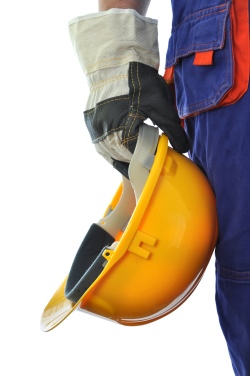PPE Focus of the Month: Head Protection and Hard Hat Safety
Head protection is a key piece of many employers’ required personal protective equipment (PPE), and rightly so. The devastation caused by head injuries, even seemingly insignificant ones, is profound. Even wounds that may seem superficial can bleed profusely, making it difficult to determine how significant the injury truly is. We must ensure that our employees are protected from known and expected hazards. Such hazards include falling objects, fixed objects that employees can strike their heads against, and electrical hazards that their heads could contact. These hazards were discussed in a previous post about hard hat safety.
Like other types of PPE, head protection should be inspected before every shift. Make sure your hard hat safety program includes teaching employees to inspect their PPE, and the importance of inspecting their PPE before each shift. Remind them that damaged head protection can lead to significant injuries if an incident occurs. And since it is their last line of defense, they don’t want it to fail when they need it most.

Frayed ends or worn stitching in the suspension system reduces the effectiveness of a hard hat. If an object were to fall on the employee’s damaged hard hat, it would not absorb the impact effectively. Less shock absorption can lead to a fractured or shattered skull.
Cracks, dents, deep scratches, or gouges are signs that the structure is compromised. The shell of the head protection could shatter and cause lacerations. Cracks in the shell can allow harmful liquid chemicals to seep through and contact the employees’ skin, leading to a wide range of complications.
Speaking of which, chemical damage and discoloration from sun exposure can also compromise the strength of the employee’s head protection.
It’s not a common practice, but employees have been known to drill holes in their head protection. Head protection can become uncomfortable because it doesn’t allow for much air flow, but adding new holes in head protection weakens it.
Some employees like to express their personality and creative sides by covering their head protection in stickers, or even painting it. This makes it difficult to inspect the head protection though. Cracks, scratches, gouges, even holes become harder to find under stickers and paint. For that reason, employees should be encouraged to find other canvases to express themselves.
It’s important that employees clean their hard hats regularly. Consider for just a moment what happens to the silica dust coating a hard hat after a long day of work. An employee casually tosses it into their car, and that dust kicks up and settles in their vehicle. Now consider what happens when that employee does that 200 or more times per year. Gradually, they are creating dangerous silica exposures for themselves, and their families. The same can be said for chemicals and other substances, too.
Keeping head protection clean is simple, and only takes a few minutes to do. Make sure that employees know to only use soap and water, because harsh chemicals can weaken the head protection.
A company’s PPE program should also account for replacing an employee’s PPE when it becomes damaged or old. The process for replacing PPE should be explained to all employees as part of their hard hat safety training, and they should be reminded of it regularly. Remember that the cost of replacing PPE is less than what the medical bills would be if the employee’s PPE failed. The easier this process is for the employee, the more likely they will follow it.
Employees should write the date on the inside when they receive new or replacement head protection. Most manufacturers recommend replacing head protection after a maximum of five years of use, though check your documentation for your manufacturer specific recommendations. Writing the date inside makes it easier to keep track of, and check, when the PPE needs to be replaced.







